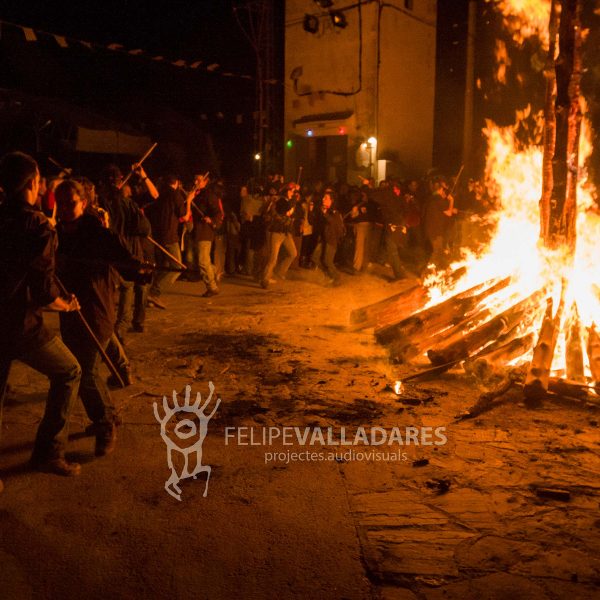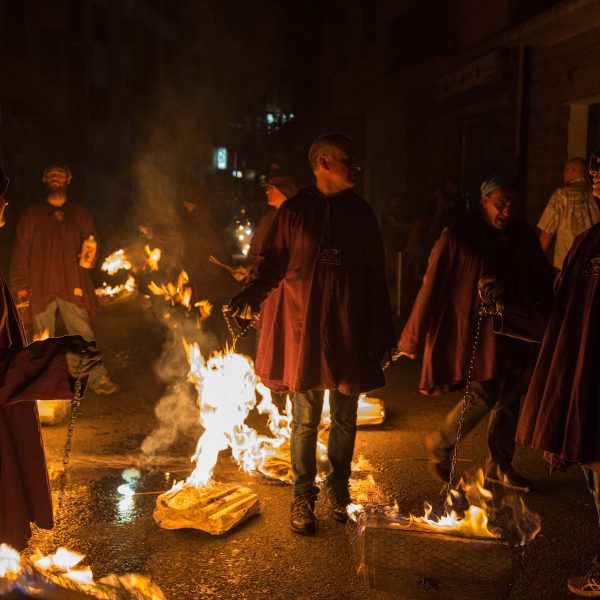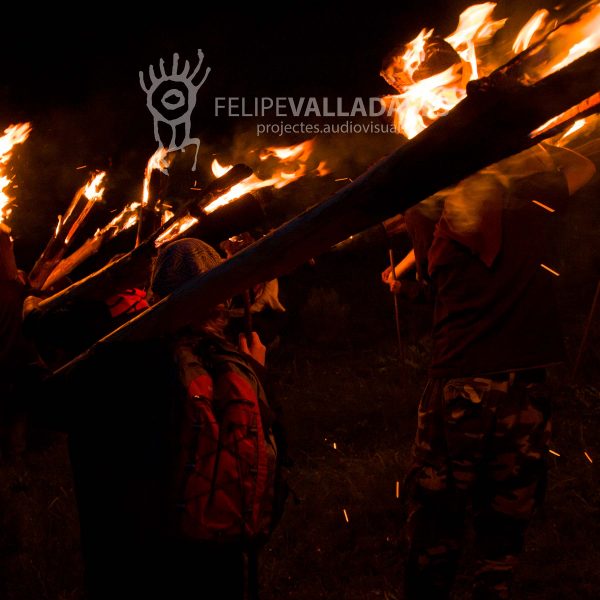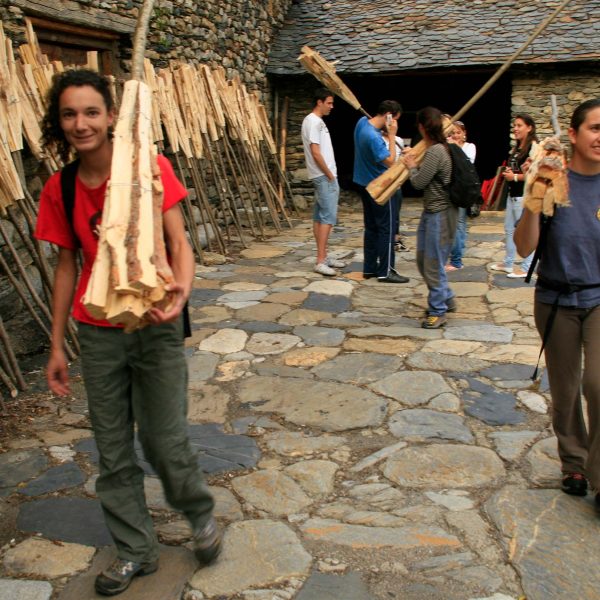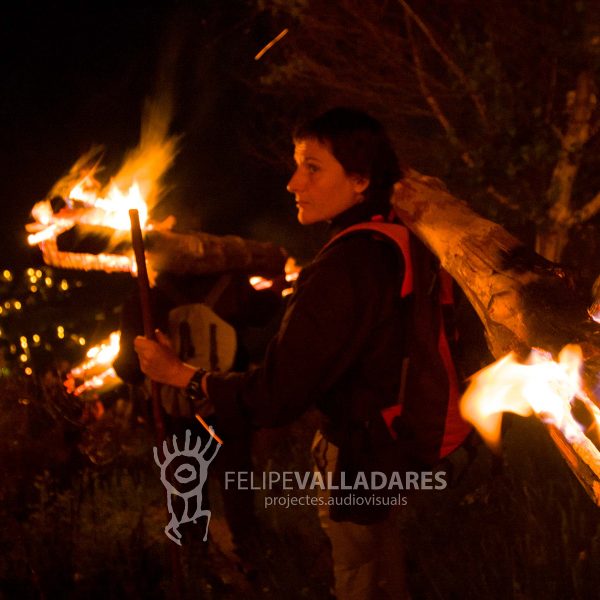Although the future of the fire festivals now appears to be in little doubt (unlike in the 20th century) and new festivals have also emerged, there are new challenges. In particular, a balance needs to be struck between the increasing size of the festivals and the fact that they are chiefly local celebrations that are important milestones in community life.
Lighting the fire year after year symbolizes continuity, but today the festivals also have a social, economic, and political value. One of the objectives of the Prometheus project and this virtual museum is to help ensure the survival of the festivals well into the 21st century.
Falles a Taüll, Alta Ribagorça, Catalunya. Photo: Oscar Rodbag
The impact of Covid on the festivals
The COVID pandemic in 2020 had a major impact on festivities in villages, which adopted four different approaches:
1) Cancellation: In some villages, government regulations led to the cancellation of the festivals in 2020, especially on the French side of the Pyrenees. This was particularly painful, as the festival had not been cancelled for many years, not even in time of war. Despite the ban, the festival was still celebrated with family and friends in small groups.
2) Smaller celebrations for the local population: With the support of the Chair of Education and Intangible Heritage of the Pyrenees, a number of fallaire groups in Pallars Sobirà (Alós, Isil, València d’Àneu and Montclar) and Pallars Jussà (La Pobla de Segur) made a video in which they said to people outside the village: “don’t come, stay at home, do it for us, do it for our people. We will be back.” In Isil, there was a symbolic act for villagers, who even brought down torches, but with far fewer people. Some residents even felt that the festivities had not been celebrated so well for years, because there were no tourists. In Pirineus Digital, a Durro resident, Enric Plaza, commented, “The pandemic has prevented tourists from coming, but it has made it possible to celebrate the falles in a more authentic way.”
3) Postponement or change of date. This option was considered in some places, such as Andorra, where the festival was postponed until the winter solstice in 2020. However, the pandemic prevented it from being held on the new date.
4) Symbolic and alternative acts, such as the burning of the falles with friends and family, or small symbolic acts, such as the reception of the Canigó flame in Andorra. The fallaires attended the event but were not able to spin the falles.
Although it was cancelled in some villages in 2021, the festival was celebrated, albeit with restrictive measures or on different dates. The COVID-19 period has caused the communities to reflect on the essence of the festival itself, its future sustainability, and its importance for the communities themselves.
Symbolic falles in Pobla de Segur, 2020
The impact of tourism on the festivals
The numbers of tourists at festivals varies considerably. In most villages, the presence of outsiders is minimal and participation is limited to villagers, owners of second homes, and friends and relatives. In other villages, however, there has been a huge increase in both fallaires and tourists, especially since the UNESCO Declaration.
Some villages have limited the number of fallaires. In Boi (2017) set a limit of 150 fallaires. Only village residents plus one per house, those registered in the Boí valley, and the holders of second homes are now permitted to carry falles. This was intended to reduce the number of tourists carrying falles. The main problem, however, is the presence of a large number of spectators. For years, restrictions have been in place at the entrances to villages to reduce vehicle congestion.
The capacity of the small Pyrenean villages is limited. In the case of Isil, the 40 inhabitants who live in the village soars to as many 4,000 people in some years. Mass tourism during the falles may lead to high hotel occupancy but at the same time it threatens the sustainability and safety of a festival that, above all, belongs to the local communities.
On the French side, the challenge is to respect the privacy of village fire celebrations, which are hesitantly opening up to the outside public. The exception is Bagnères-de-Luchon, a spa town, which attracts a large number of tourists.
Sustainable festivals
The fire festivals should be a clear example of harmony with nature; only resources that are sustainable should be selected. The commitment to the sustainability of the festival must be one of the highest aspirations of the fallaire communities. A range of different challenges need to be met: environmental sustainability, such as the use of natural spaces and resources; a reduction in numbers of participants and vehicles in cases of overcrowding; awareness of and respect for the importance of the festivities as heritage; and, above all, a promotion of cultural sustainability.
Falles and gender
In the past, men and women played very different roles in the fire festivals, a reflection of the fact that there was considerable inequality in traditional societies. Although practices varied, it was generally only the men who brought down the falles, while the women waited for them in the village. And only men prepared the brandons.
Today, on the French side, the division of labor is still marked: the work of cutting and preparing the brandon is generally done by men, while the organization of the festivities is carried out by the associations and village councils. Women can now occupy positions of responsibility (as president of the festival committee or mayoress, for example) and are no longer just spectators.
Little by little, differences have been overcome, although in some cases the changes are recent and not without resistance or debate.
In Taüll, a village vote in 2008 ratified the ban on women bringing down falles, a ban that was defied by six women. This caused a local controversy, and the beacon was not lit in protest at the involvement of women. A year later, a group of fallaires used a different route in protest at women’s involvement. Since 2010, women have carried the falles without incident.
In La Pobla de Segur, the participation of women in the descent was approved in 2018, at a meeting of the Pobla de Segur fallaire cultural association, the body that organizes the festival. The decision was made at the request of two members who claimed that “traditions must evolve as society evolves and must be suited to the new circumstances in order to remain connected to ordinary villagers, who risk ceasing to identify with the festival.” The organizing association reported that “from now on, in the falles of La Pobla de Segur, without altering the structure of the festival, which calls for couples to be formed by one person dressed as fallaire and one as pubilla, both men and women can exercise the role that best suits them.”
The evolution of intangible heritage practices towards full gender equality is a basic principle of UNESCO with respect to inscriptions on its Representative List.
 Occitan
Occitan




